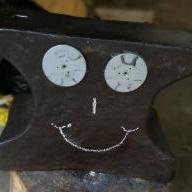
dickb
Members-
Posts
272 -
Joined
-
Last visited
Profile Information
-
Gender
Not Telling
-
Location
Suffern , NY
Converted
-
Location
suffern,ny
Recent Profile Visitors
5,455 profile views
-
dickb started following Sharpening Stone , Dog's head hammer pros and cons , Forge design, and clinkers and 4 others
-
What are the advantages and/or disadvantages of using a dog's head hammer ?
-
Here's a couple of things you can do. Using square or round stock, forge a few four sided tapers. A taper is like a pyramid with four sides. Make them about an inch or two inches long. Tongs not needed . Rebar is okay for this. Repeat the above to make some round tapers, like an ice cream cone. This will give you a very basic feeling of how to forge iron. Since tongs are so important, you can make some with little or no experience. Check Youtube for "how to make tongs without tongs". Don't worry if the first pair is not great. The next pair you make will be much better.
-
I don't see anything that looks like a clinker breaker or an ash dump. Either or both of these will let you clean out accumulated ash and clinkers without disturbing the fire too much. You can drag a poker with an "L" shaped end bend at the end through the fire and drag the bigger clinkers out of it. That will help with big clinkers but not with the accumulated ash. Your firepot has an "S" shaped grate. If this grate is not moveable then ash will build up and clog the air flow. If you can modify the grate so it can be rattled around without disturbing the fire the you will be able to avoid the ash buildup.
-
What is the "established terminology for what I am calling spine side and edge side." ?
-
For this post I define "spine side" and "edge side" as it relates to grinding a knife blade. If the abrasive (flap disk or belt sander) is moving from the spine toward the cutting edge, I would call this "spine side" If the abrasive (flap disk or belt sander) is moving from the cutting edge toward the spine, I would call this "edge side". In my opinion the "spine side" is safer because it's almost impossible for the abrasive to bite into or grab the blade and throw it at high speed. In the "edge side" mode, too much pressure or wrong angle of attack could force the blade to cut into or grab the abrasive belt of flap disk with unpredictable/dangerous results.
-
The problem I need help with is how to open the initial hole so it is collinear with the axis of the handle , or at least parallel to the axis of the handle.
-
Can anyone suggest some kind of simple jig to drill a solid piece of wood to enclose the tang on a hidden tang knife. The stock will have one clean flat side but the end of the material may not be square to that side. I stress "simple jig" because I don't have much more than common woodworking tools and an electric drill. Thanks
-
The bearings/seals where the crank handle meets the body of the blower are worn and leaky, so oil frequently gets down the vertical column and wets the threads on the cast iron base. Maye that contributes to the connection loosening up.
-
I already tightened the post to base connection as tight as I could but it loosened up after a few minutes. The question remains, is there any locking mechanism on the bottom side of the cast iron base ?
-
I am using a Canedy Otto blower. The model is Western Chief. The blower is complete with all original parts and mountings. The base appears to be cast iron and it's bolted to the stone floor. A steel column about four inches across is threaded to fit the cast iron base. The blower mechanism is mounted to the top of this steel column. After a few minutes of use, the steel column and blower mechanism (both acting as a single unit) loosen up from the cast iron base and the blower is not stable and/or safe. Can anyone suggest a fix ?
-
Best Online Beginner Supplies (Tools/Stock)
dickb replied to MaybeASmith's topic in Blacksmithing, General Discussion
Companies who fabricate fences, welding shops are good sources for "drops", i.e. cutoffs from other jobs. -
I have seen bladesmiths fully harden a knife blade and then soften the spine of the blade while keeping the edge cool. This has been called "bluebacking" What are the pros and cons of this technique?
-
I will be sharpening 1095, 1080, 5160 steel knife blades. The stone is very old and very thin. It broke in half but I managed to use Crazy Glue to join the two pieces together. It's working fine right now but it's only a matter of time until it breaks again. We don't have flea markets around here but we do have garage sales, so I'll give that a try when they start in a couple of months.
-
I apologize in advance because I think this is the wrong place for this post. I need to replace my old, old combination Carborundum bench stone. I see so may types of stones available that my head is spinning. Would prefer a combination stone about eight inches long in the range of twenty to thirty dollars. I would appreciate any advice as to what material (silicon carbide, green silicon carbide, aluminum oxide, etc. ) would be a good choice.


